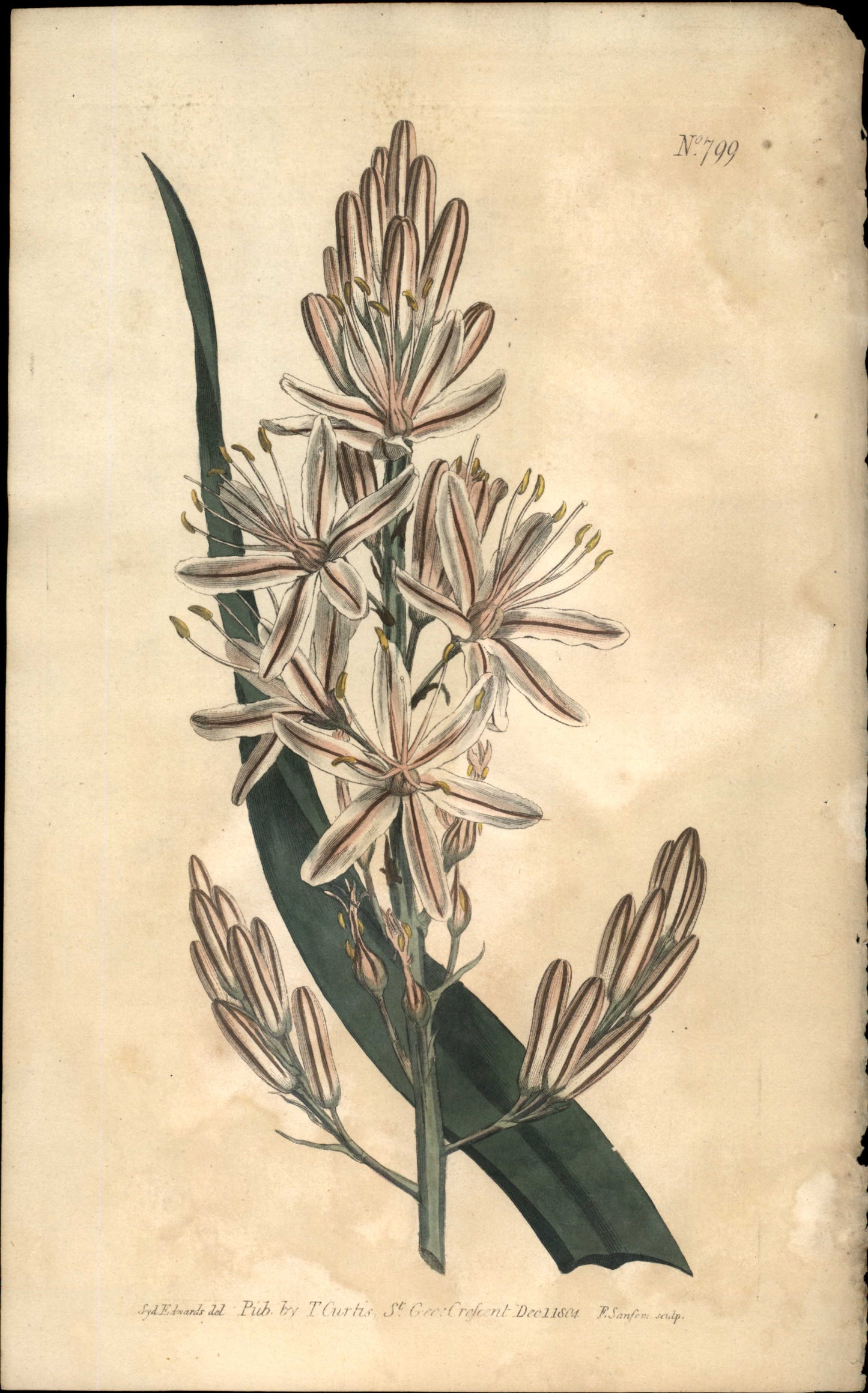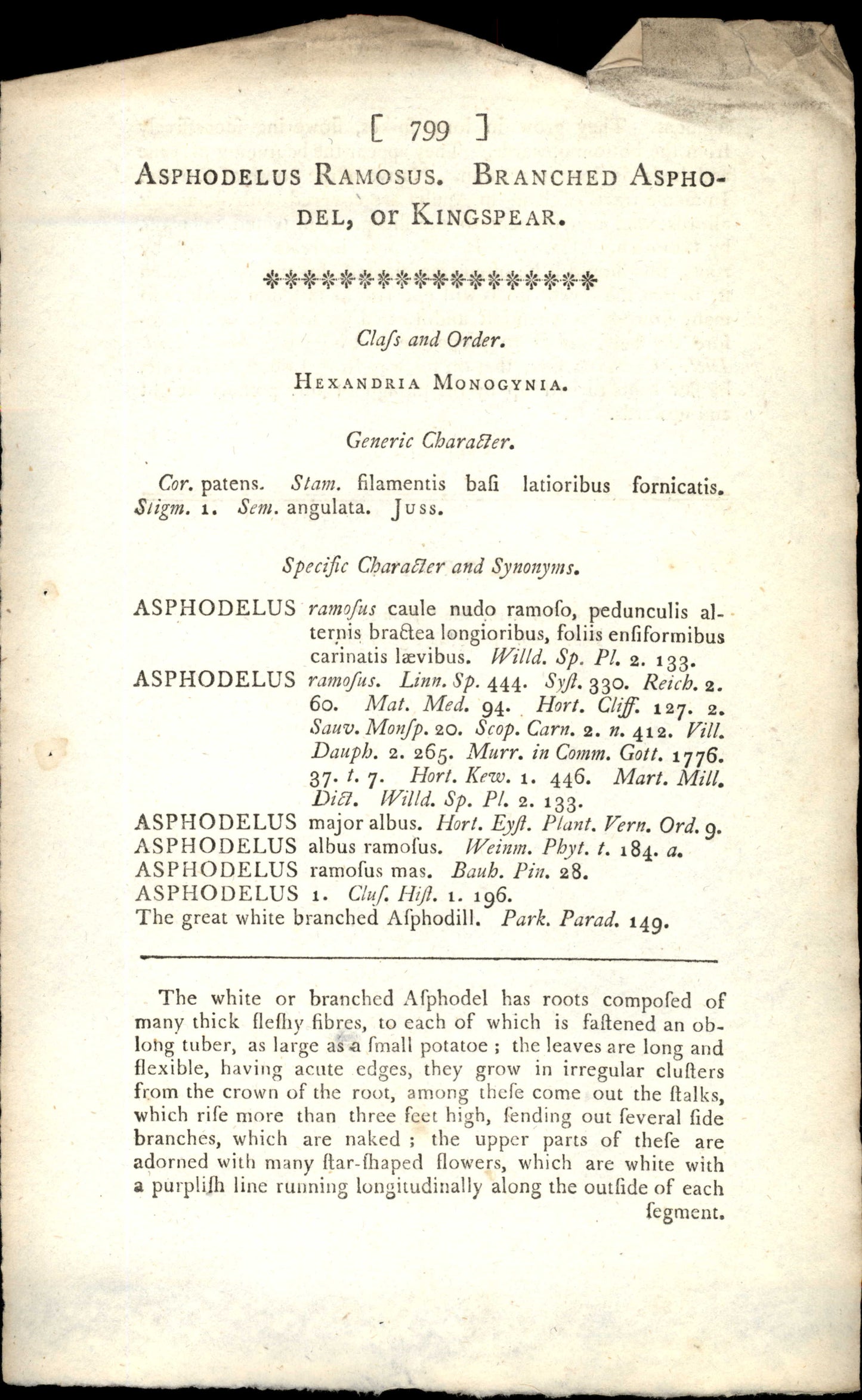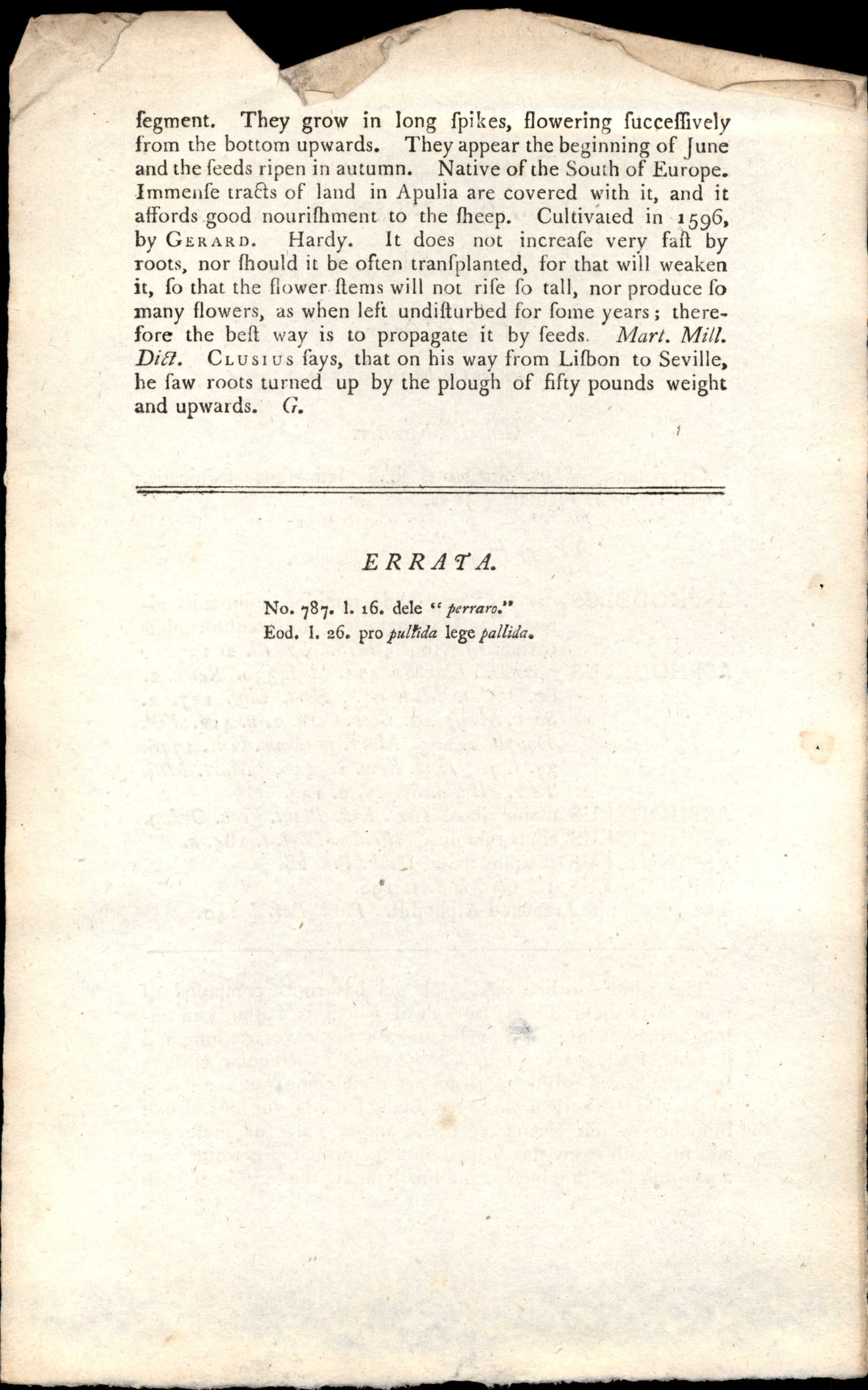Curtis Botanical Magazine
Plate 799 - Asphodelus Ramosus
Plate 799 - Asphodelus Ramosus
Couldn't load pickup availability
Plate 799
Classification: HEXANDRIA MONOGYNIA
Native Region: Europe
Flowering Period: June
Publication Date: Dec.1.1804
Description:
Complete Botanical Text (Cleaned)
[ 799 ] AsPHODELUS RAMOSUS.
BRANCHED AsPHO- DEL, or KINGsPEAR. ************* Class and Order.
HEXANDRIA MONOGYNIA.
Generic Character.
Cor. patens. stam. filamentis basi latioribus fornicatis. stigm. 1.
Sem. angulata.
Juss. specific Character and synonyms.
AsPHODELUS ramofus caule nudo ramoso, pedunculis al- ternis bracttea longioribus, soliis ensiformibus carinatis lævibus.
The white or branched Afphodel has roots compofed of many thick flefhy fibres, to each of which is fastened an ob- long tuber, as large as a fmall potatoe; the leaves are long and flexible, having acute edges, they grow in irregular clufters from the crown of the root, among these come out the stalks, which rife more than three feet high, fending out several fide branches, which are naked; the upper parts of these are adorned with many ftar-shaped flowers, which are white with a purplifh line running longitudinally along the outside of each segment N.799 syd Edwards del Pub by TCurtis, st Gee: Crefcent Dec11804 P.Sanfem sep segment.
They grow in long spikes, flowering fucceffively from the bottom upwards.
They appear the beginning of June and the seeds ripen in autumn.
Native of the South of Europe.
Immenfe tracts of land in Apulia are covered with it, and it affords good nourishment to the sheep.
Cultivated in 1596, by GERARD.
Hardy.
It does not increafe very fait by roots, nor should it be often transplanted, for that will weaken it, so that the flower stems will not rife so tall, nor produce so many flowers, as when left undisturbed for some years; there- fore the best way is to propagate it by seeds.
Mart.
Mill.
Dict.
CLUSIUS says, that on his way from Lifbon to Seville, he saw roots turned up by the plough of fifty pounds weight and upwards.
G.
ERRATA.
No. 787. 1. 16. dele "perraro." Eod. 1. 26. pro pultida lege pallida
Raw OCR Text (Original)
[ 799 ] AsPHODELUS RAMOSUS. BRANCHED AsPHO- DEL, or KINGsPEAR. ************* Class and Order. HEXANDRIA MONOGYNIA. Generic Character. Cor. patens. stam. filamentis basi latioribus fornicatis. stigm. 1. Sem. angulata. Juss. specific Character and synonyms. AsPHODELUS ramofus caule nudo ramoso, pedunculis al- ternis bracttea longioribus, soliis ensiformibus carinatis lævibus. Willd. sp. Pl. 2. 133. AsPHODELUS ramofus. Linn. sp. 444. syst. 330. Reich. 2. 60. Mat. Med. 94. Hort. Cliff. 127. 2. Sauv. Monfp. 20. scop. Carn. 2. n. 412. Vill. Dauph. 2. 265. Murr. in Comm. Gott. 1776. 37. t. 7. Hort. Kew. 1. 446. Mart. Mill. Diat. Willd. sp. Pl. 2. 133. AsPHODELUS major albus. Hort. Eyft. Plant. Vern. Ord. 9. AsPHODELUS albus ramofus. Weinm. Phyt. t. 184. a. AsPHODELUS ramofus mas. Bauh. Pin. 28. AsPHODELUS 1. Cluf. Hift. 1. 196. The great white branched Afphodill. Park. Parad. 149. The white or branched Afphodel has roots compofed of many thick flefhy fibres, to each of which is fastened an ob- long tuber, as large as a fmall potatoe; the leaves are long and flexible, having acute edges, they grow in irregular clufters from the crown of the root, among these come out the stalks, which rife more than three feet high, fending out several fide branches, which are naked; the upper parts of these are adorned with many ftar-shaped flowers, which are white with a purplifh line running longitudinally along the outside of each segment. N.799 syd Edwards del Pub by TCurtis, st Gee: Crefcent Dec11804 P.Sanfem sep. segment. They grow in long spikes, flowering fucceffively from the bottom upwards. They appear the beginning of June and the seeds ripen in autumn. Native of the South of Europe. Immenfe tracts of land in Apulia are covered with it, and it affords good nourishment to the sheep. Cultivated in 1596, by GERARD. Hardy. It does not increafe very fait by roots, nor should it be often transplanted, for that will weaken it, so that the flower stems will not rife so tall, nor produce so many flowers, as when left undisturbed for some years; there- fore the best way is to propagate it by seeds. Mart. Mill. Dict. CLUSIUS says, that on his way from Lifbon to Seville, he saw roots turned up by the plough of fifty pounds weight and upwards. G. ERRATA. No. 787. 1. 16. dele "perraro." Eod. 1. 26. pro pultida lege pallida.
Original botanical print from Curtis's Botanical Magazine
Share







